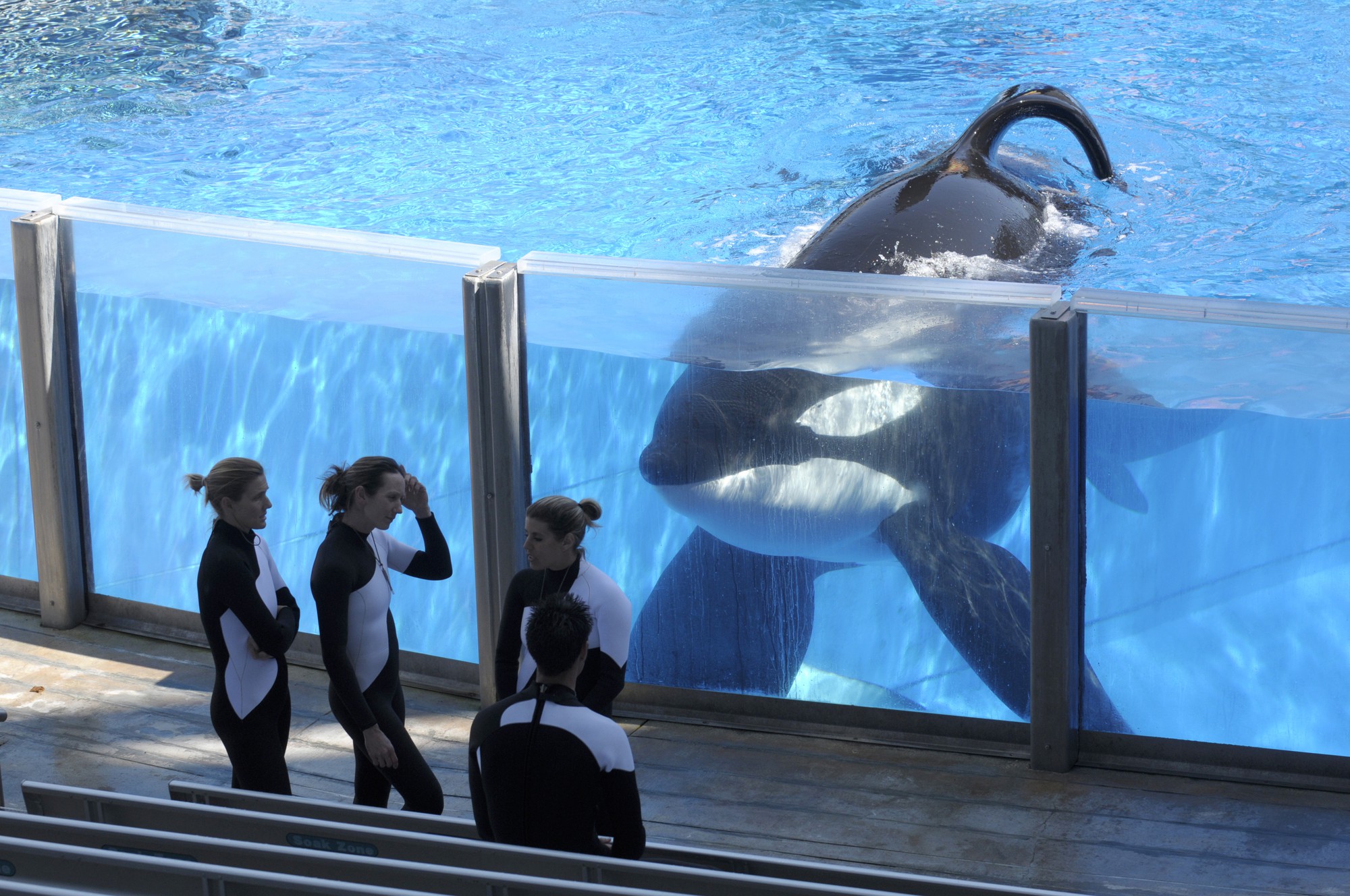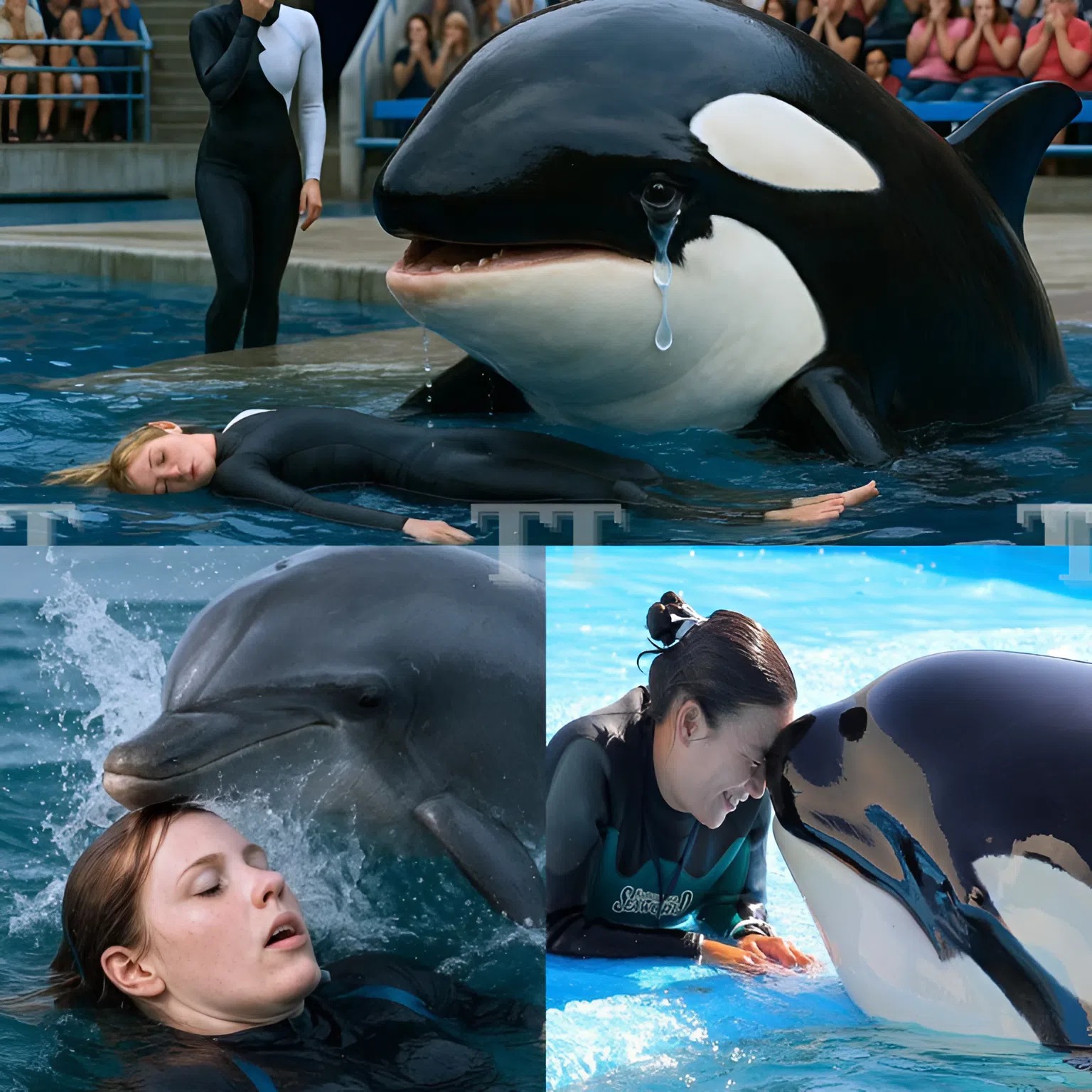What began as a routine marine-life performance in San Diego turned into an unforgettable display of instinct and cooperation between humans and animals. In this fictional retelling inspired by real marine-life behaviors, a trained dolphin named Nalu became the center of global attention after responding swiftly to an unexpected incident during a synchronized routine.
The show, typically known for its choreography of jumps, dives, and water formations, took an unexpected turn when a performer slipped during a platform sequence. While the moment caused brief confusion among staff and visitors, it never escalated into danger. Instead, it became an opportunity to witness the bond between the dolphin and her human partner.
In this imagined scenario, Nalu’s immediate and intelligent response highlighted what marine biologists have long documented: dolphins are among the most socially aware and quick-thinking species in the animal kingdom. The audience, initially startled, soon found themselves applauding one of the most touching moments they had ever seen at a marine park.
The Performance Begins as Usual

The day started like any other show. Families, students, and tourists filled the seats, expecting an afternoon of choreographed splashes and playful interactions. The trainers introduced Nalu, a bottlenose dolphin trained for coordinated routines involving acrobatics and synchronized dives. Nalu’s reputation among regular visitors was well-known; she was recognized for her energy, enthusiasm, and immediate responsiveness to cues.
The first portion of the program unfolded smoothly. Nalu and her human partner executed sequences that demonstrated rhythm, trust, and mutual understanding developed over years of training.
However, during a transition between the diving routines, the performer misstepped and slipped from the platform into the deeper area of the pool. It was clear the moment was not part of the choreography, and staff near the pool prepared to intervene if needed. What happened next surprised even the experienced trainers who had worked with Nalu for years.
Nalu’s Swift, Thoughtful Response
Dolphins are known for their sensitivity to human behavior, especially during training. In this fictional version of events, Nalu paused for a brief second before diving below the surface. Spectators initially held their breath. Trainers prepared to assist, but Nalu resurfaced almost immediately beneath her partner.
In a coordinated motion, Nalu guided the performer gently toward the pool’s edge. The staff quickly stepped in to help the trainer out of the water. The performer, more startled than injured, needed only a moment to regain balance and reassure the crowd. She later described Nalu’s reaction as “calm, purposeful, and almost instinctive.”
The dolphin emitted a series of soft, high-pitched whistles—behavior marine biologists associate with attention-seeking signals, communication, or reassurance within a pod.
To the audience, the interaction appeared almost like a natural extension of the trust the pair had built through daily training. It was not a dramatic rescue, nor an emergency scenario, but a moment of cooperation that showcased the emotional intelligence dolphins are known for.
The Science Behind the Bond
Marine specialists who teach animal behavior often highlight the unique cognitive abilities of dolphins. Research shows that dolphins respond to familiar faces, gestures, vocal tones, and emotional shifts. In structured environments, trainers and dolphins develop clear communication systems through repetition, reward-based learning, and consistent routines.
In this fictional account, Nalu’s quick response is a reflection of what real marine biologists observe in trained environments:
-
Dolphins can interpret human body language.
A trainer losing balance or slipping appears visually different from a typical cue. -
They respond to emotional indicators.
Sudden changes in posture or behavior can prompt a dolphin’s attention. -
Their memory and pattern recognition are strong.
Dolphins recall routines easily, allowing them to detect when something falls outside the expected sequence. -
Years of cooperative work create familiarity and trust.
The dolphin and trainer understand each other’s rhythms, lowering hesitation in unexpected moments.
Experts emphasize that such moments—while heartwarming—are not miraculous; they are the result of structured training, consistency, and social intelligence.
The Performer’s Reaction

After being helped out of the water, the performer took a moment to acknowledge Nalu with a gentle touch and a reassuring gesture. According to the fictional recounting, she later shared that the dolphin had been “one of the most constant presences” in her professional life. Years of daily practice had created a bond built on trust, predictability, and shared experiences.
She went on to describe the moment as “a reminder of how closely connected humans and animals can become in cooperative settings.” Her comments highlighted a growing understanding in the wildlife community that emotional connection can exist without anthropomorphizing animals or assigning them human motives. Instead, it can be appreciated as evidence of responsiveness, intelligence, and well-established training methods.
A Crowd Moved by an Unexpected Moment
Spectators, initially unsure of what they were witnessing, quickly rose to their feet once the situation became clear. The applause was not prompted by a dramatic stunt, but by an authentic interaction that underscored the importance of empathy—whether between animals, humans, or both.
Families described the moment as uplifting and unexpectedly educational. Some visitors said the experience deepened their appreciation for marine animals, encouraging them to learn more about marine biology, conservation efforts, and the ethical treatment of trained wildlife.
Children expressed fascination with Nalu’s actions, while adults reflected on the emotional sincerity of the moment. The standing ovation that followed was less about entertainment and more about recognition of the connection between species.
Nalu’s Last Swim of the Afternoon
As the show concluded, the trainers made the decision to let Nalu swim a relaxed, unscripted lap around the pool—something she often enjoyed during cool-down sessions. The audience remained seated, watching the dolphin glide through the water with smooth, confident movements.
Applause filled the arena once more. Though fictional, the moment symbolizes how animals and humans can share meaningful interactions that resonate far beyond the immediate setting.
Visitors left the venue with a renewed respect for marine life—not because of a choreographed performance, but because of a spontaneous expression of awareness and cooperation.
A Story That Highlights Understanding, Not Fear
In contrast to dramatic or alarming narratives often found online, this reimagined account focuses on:
-
Intelligence instead of danger
-
Awareness instead of crisis
-
Calm responsiveness instead of shock
The fictional moment reminds us that marine animals possess remarkable cognitive abilities that continue to inspire and educate. It also emphasizes that respectful, science-based training can create safe, enriching environments for both animals and humans.
Sources
-
National Geographic – Dolphins: Social Behavior and Intelligence
-
Smithsonian Magazine – How Marine Mammals Communicate and Respond to Human Signals
-
BBC Earth – Understanding the Bond Between Trainers and Marine Animals
